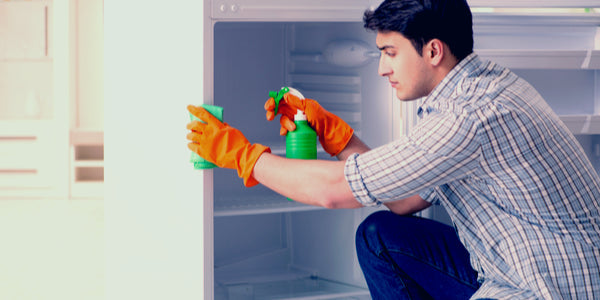
Did you know dieting habits can be associated with the cleanliness of a fridge and its contents? A recent study investigated the refrigerator and found that the fridge plays an important role in eating habits.
Fridge cleaning hacks can enhance the organization and provide a powerful visual for selecting healthier foods once inside. A fridge (and freezer) can act as a gateway for reflection and discovery, and keeping it clean allows for a fresh slate of food choices and healthy habits.
Unsure on how to get started? Read on for the best hacks on how to clean your fridge!
Products to Leave Your Fridge Spotless
A clean kitchen means a home less likely to harbor harmful bacteria or other toxins. The following products are perfect for keeping a refrigerator food-safe and user-friendly.
Non-Toxic & Green Cleaning
Instead of relying on harsh chemicals for deep cleaning, try to go green and use non-toxic products. (See below for DIY cleaners!)
For instance, instead of going through an entire roll of paper towels, go green with a microfiber cloth or another reusable towel.
For a guide to healthy cleaning that is non-toxic for food and those who eat it, search the Environmental Working Group's database for more information on top products, label decoding, and recent research or updates.
Do-It-Yourself All-Purpose Cleaners
Make a DIY cleaning solution out of household objects that can commonly be found in most homes. In fact, plain old hot water can even do the trick for cleaning off removable shelves and drawers!
Another quick, DIY fridge solution from Good Housekeeping includes mixing 4 tablespoons baking soda with 1 quart of warm water. It can also be used to shine and remove spots from stainless steel when mixed into a paste.
Other valuable cleaning items include dish soap, white vinegar, a spray bottle. Overall, though, thoroughly read all directions and test out areas before applying to surfaces.
Organization Methods
Refrigerators are so high-tech these days that it can be difficult to know how best to organize its contents.
The following methods take the guesswork out of organizing and can help to clarify the process, possibly saving resources such as time, money, and energy along the way.
Out with the Old
Prioritize routine intervals to clean out the fridge of expired foods. Spoiled food can keep bacteria and toxins lurking in hard to reach places.
Systematic cleaning schedules make for a safer space for meal prep and menu plans. Just 5 to 10 minutes every few weeks can be sufficient to sort through expired food and toss it out.
Messes can become overwhelming, but constantly having to wonder about the quality of the fridge and the food inside can become even more worrisome of a burden.
Fridge Inventory Management
Whether manually or with an assistive device, fridge inventory management can control and monitor inventory can keep foods safely stocked and managed. It also reduces overall food waste.
Managing fridge inventory can be as simple as a pen and paper list secured with a magnet to the front of the fridge. Or, it can be as complex as a specialized digital device.
Either way, taking the time to manage inventory can keep foods tidy and clean.
Make It a Game
Research has found evidence that games can be an effective tool for education, even when it comes to organizing the fridge so food stays fresh for longer.
Challenge kids to remember how to properly organize the fridge or make it a contest to see who is the best at cleaning out expired food.
Must-Have Items
Having certain items on hand can ensure the health and cleanliness of a fridge and its contents. These include a thermometer and visual references and reminders. Using smart technology is optional, but effortlessly helpful.
Refrigerator Thermometer
Many fridges come equipped with thermometers these days. However, have an accurate tool on hand to make sure that the fridge is kept at the appropriate temperature, which is 5°C (41°F) or below.
Visual References & Other Reminders
It can be hard to remember everything about food safety and fridge methods, so visual reminders or mnemonic cues can come in handy.
Consider what practices or rules could help improve the family meal prep process and then implement them. The Academy of Nutrition and Dietetics recommends "The Core Four" (Clean, Separate, Cook, and Chill), which are four easy steps to keep in mind when it comes to fridge and kitchen safety for food.
Smart Technology
Smart technology is expanding to common households, and many new options have specialized temperature control. While not exactly necessary for cleaning a refrigerator, such settings can help keep food at its best quality for consumption.
See what applications are available for assistive devices or find out the special features when shopping for a new fridge.







